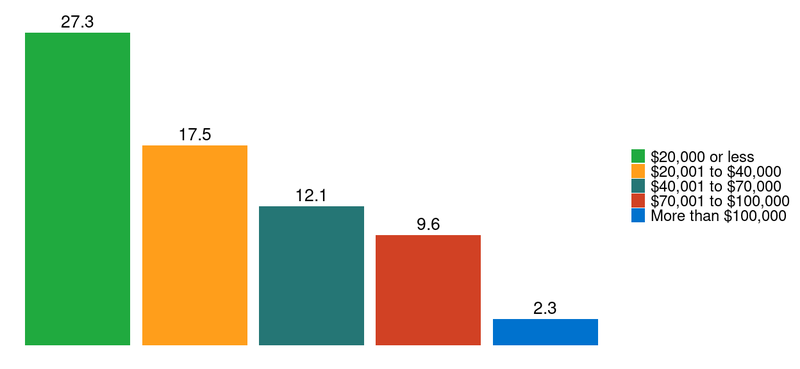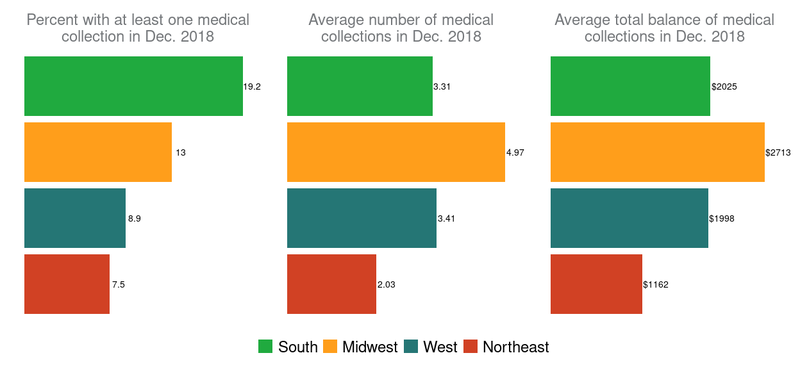
. Despite private insurance coverage and government programs like Medicare and Medicaid that cover all or part of the cost of medical treatments, consumers continue to incur significant medical expenses. By 2028, healthcare-related expenses are projected to reach $6.2 trillion.
The Affordable Care Act (ACA) requires nonprofit hospitals to establish financial assistance policies—often known as “charity care” 1 —for consumers who are unable to pay for these expenses. In this blog, we explore the connection between eligibility for these financial assistance programs and the prevalence of medical collections using data from the CFPB’s Making Ends Meet survey.
Many Americans, especially those with lower incomes, can’t afford to pay the high cost of medical care, and unpaid medical debts may eventually end up in collections and on consumers’ credit reports. The ACA prohibits
nonprofit hospitals from reporting medical debts as collections to credit reporting companies, or from selling the debt to another party, without first trying to determine whether the patient would be eligible for their financial assistance policies. We find, however, that even with these policies in place a large percentage of low-income consumers in 2018 had at least one medical collection on their credit reports.
The data indicate that as household incomes decrease, a higher percentage of consumers have medical collections. Figure 1 shows that 17.5 percent of those with household earnings between $20,001 and $40,000 in 2018 had at least one medical collection on their credit report. This fraction grows to 27.3 percent for people whose household income was less than $20,000.
Figure 1: Percentage of households with at least one medical collection in December 2018, by income

Some state laws have established eligibility thresholds as a percentage of federal poverty levels, which are based on both income and household size. Consequently, both factors are often relevant when determining a person’s eligibility for financial assistance. While we don’t have complete data on household size from the Making Ends Meet survey, we do know whether children are present in a household. Combining this information with data on income provides further insight into the relationship between financial assistance eligibility and the prevalence of medical collections on consumers’ credit reports.
Figure 2 shows that among people in households with children and with incomes under $40,000—many of whom would fall under 200 percent of the federal poverty threshold for their household size 2 —38.1 percent had at least one medical collection on their credit report in December 2018. This is nearly three times the rate for people without children earning the same amount.
Figure 2: Percentage of households with at least one medical collection in December 2018 by income and household composition
 of medical collections between people with and without children earning $40,000 or less and earning $40,001 or more per year. Among those earning $40,000 or less, 38.1 percent of people with children and 13.4 percent of people without children had at least one medical collection in December 2018. Among those earning over $40,000 annually, 10.6 percent of those with children and 6.3 percent of those without children had at least one medical collection." width="800" height="369" />
of medical collections between people with and without children earning $40,000 or less and earning $40,001 or more per year. Among those earning $40,000 or less, 38.1 percent of people with children and 13.4 percent of people without children had at least one medical collection in December 2018. Among those earning over $40,000 annually, 10.6 percent of those with children and 6.3 percent of those without children had at least one medical collection." width="800" height="369" />
Different outcomes also arise based on the region of the country consumers live in. Figure 3 shows that the Northeast (depicted with red) has the fewest medical collections per person and the lowest average collection balances among those with one collection or more. The South (in green) has the highest percentage of individuals with a medical collection, while the number of collections and total amount owed are highest in the Midwest (in yellow).
Some of the regional differences may be explained by differences in the adoption of Medicaid expansion, differences in income levels, or differences in the rates of medical insurance coverage. State laws and programs related to the provision of financial assistance also appear to differ significantly across the country. Further research is needed to determine the extent to which the different outcomes in Figure 3 are also the result of differences in state financial assistance policies.
Figure 3: Medical collection prevalence and size by region
 of medical collections among those with at least one, and the average total balance of those medical collections. 19.2 percent of residents of the South have at least one medical collection. Those with medical collections in the South have an average of 3.31 medical collections for an average total balance of https://files.consumerfinance.gov/f/images/cfpb_mecical-collections-blog_figure-3_2022-08.width-800.png,025. 13 percent of residents of the Midwest have at least one medical collection. Those with medical collections in the Midwest have an average of 4.97 medical collections for an average total balance of https://files.consumerfinance.gov/f/images/cfpb_mecical-collections-blog_figure-3_2022-08.width-800.png,713. 8.9 percent of residents of the West have at least one medical collection. Those with medical collections in the West have an average of 3.41 medical collections for an average total balance of ",998. 7.5 percent of residents of the Northeast have at least one medical collection. Those with medical collections in the Northeast have an average of 2.03 medical collections for an average total balance of ",162." width="800" height="369" />
of medical collections among those with at least one, and the average total balance of those medical collections. 19.2 percent of residents of the South have at least one medical collection. Those with medical collections in the South have an average of 3.31 medical collections for an average total balance of https://files.consumerfinance.gov/f/images/cfpb_mecical-collections-blog_figure-3_2022-08.width-800.png,025. 13 percent of residents of the Midwest have at least one medical collection. Those with medical collections in the Midwest have an average of 4.97 medical collections for an average total balance of https://files.consumerfinance.gov/f/images/cfpb_mecical-collections-blog_figure-3_2022-08.width-800.png,713. 8.9 percent of residents of the West have at least one medical collection. Those with medical collections in the West have an average of 3.41 medical collections for an average total balance of ",998. 7.5 percent of residents of the Northeast have at least one medical collection. Those with medical collections in the Northeast have an average of 2.03 medical collections for an average total balance of ",162." width="800" height="369" />
The average number of medical collections and the average balance of medical collections are calculated for those with at least one medical collection on their credit records in December 2018
The three nationwide credit reporting companies – Experian, Equifax, and TransUnion – have announced changes in how unpaid medical bills will appear on consumer credit reports. In July 2022, all three began removing paid medical collections from credit reports, and starting in 2023 they will no longer report medical collections below $500. The companies have also increased the amount of time after which a medical bill can appear on a credit report from six months to one year.
These changes have the potential to improve the credit of low-income individuals who – despite possible eligibility for financial assistance – have medical collections on their credit reports. However, many low-income consumers are still unlikely to benefit because their existing medical bills exceed the $500 threshold. Among consumers with medical collections on their credit records, 48 percent of those making less than $40,000 per year in 2018 had at least one collection for over $500 at the time. Collections like these will continue to weigh on consumers' credit outcomes. Credit reporting changes notwithstanding, access to financial assistance will continue to be important for the lowest income households.
Even though many low-income consumers are eligible to receive financial assistance, a large percentage of consumers with low incomes have medical collections on their credit reports. We lack the data to identify debts incurred from nonprofit hospitals, so many of these debts may come from for-profit and other providers. Nonprofit hospitals, however, make up approximately 49 percent of all hospitals
. These hospitals must provide financial assistance and other community benefits in exchange for the significant tax benefits they receive, yet our results suggest that many consumers do not receive the financial assistance they need.
Different regions of the country also experience very different outcomes with medical collections, some of which may be attributed to differences in state laws and other programs regarding financial assistance. Future research could explore the extent to which differences in legislative and regulatory environments influence the provision of financial assistance and lead to better financial outcomes for consumers.
The views expressed here are those of the authors and do not necessarily reflect the views of the Consumer Financial Protection Bureau. Links or citations in this post do not constitute an endorsement by the Bureau.